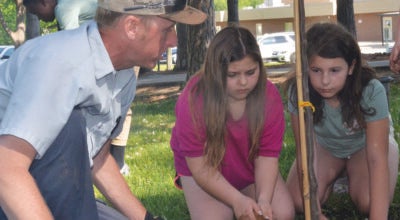Too Crowded? Decide For Yourself; Davie High Tours Scheduled
Published 12:00 am Monday, January 14, 2013
By Beth Cassidy
Enterprise Record
A small group of residents gathered at Davie High recently to tour the facilities and see some of the problems identified by school board members.
Security and keeping students safe is an ongoing issue, especially with mobile units, said Assistant Superintendent for Operations Jeff Wallace, a former principal at the school, who led the tour.
Twenty-four of the campus’ 29 mobile units are used for classrooms. English, math, social studies, foreign language, English as a second language, career technical education, JROTC, health and special education classes are taught in mobiles. The other five are used for storage and offices.
All regular classroom doors can be swiftly locked with the flip of a switch in the main office, but that does not apply to the mobile units, Wallace said.
“Ninety percent of the doors can be locked automatically by the principal, but we can’t lock any mobiles. The safest configuration would be to have every student under one roof,” he said.
Doors to the mobiles can be locked from the inside, said Principal Jinda Haynes.
“Each mobile has two doors, with the exception of one that has three doors. One door typically remains locked and is not used. The other one can be locked and unlocked by the teacher and custodians, and all can be locked from the inside,” she said.
Wallace said when students are changing classes, they are in open breezeways and crossing campus, from the old tennis courts to the bus parking lot on the opposite side of campus. Doors to the buildings have to remain unlocked at all times, for student access.
The group of six plus administrators toured the science classroom hall. Haynes said that not all of the science classrooms have gas, so if a lab is going on that involves gas, teachers have to switch rooms. In one of the labs, there were 25 students, with one of the student’s desks pushed into a back corner and the side up against a cabinet. The desk was occupied.
Haynes said to be qualified as a science classroom, the room has to have a sink, but not all do, and the sink in one of the rooms has a plumbing issue that cannot be fixed.
The group paused to notice the lockers chained shut, because doors cannot be opened into the hallways. Wallace said students carry bookbags around with them all day, although they are generally able to leave them in the classroom when they go to lunch.
One of the biggest problems, he said, is with athletes who bring bags of sports equipment when they come to school and are faced with either carrying that around along with their bookbag all day or having a teacher store the bag under tables in classrooms, which can be a violation of the fire code.
During a class change, students filled the hallway, and the touring group lined the walls to let students pass. Breakfast carts on the sides of the hall were busy.
“We found, when I was principal, that many of these kids weren’t getting anything to eat in the morning, and since the last lunch doesn’t start until 1:15, that’s a long stretch for someone who hasn’t eaten,” said Wallace.
Instead of having the students go to the carts, the decision was made to take the carts to the students, and many more are being served than before, going from an average biscuit sale of 83 to more than 500 per day. The students at the carts contribute to the congested hallway, Wallace said.
During the tour, one student shouted, “One new high school.”
In looking at other classrooms, Haynes said with the new national common core standards and the new statewide curriculum changes, there is a greater need than ever before for more hands-on learning and group work.
“We need flexibility to be able to provide that, in terms of furniture and space and we just don’t have that now,” she said.
The group saw the auto-tech area, where students wanting to take the class are turned away every semester, because federal guidelines mandate only 16 students can be in each class, and the theater area, hearing from teacher Rebecca Edwards that her classes do everything in one space, building sets and rehearsing, with everyone having to raise their voices to be heard over the adjoining …





